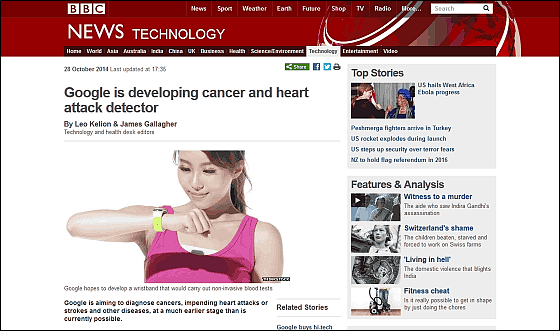Google is developing devices that can detect cancer, cardioplegia, stroke, etc. at an extremely early stage with nanoparticles

ByJfcherry
Google launched a company to combat aging phenomena and old age disease, sell genetic test kits,Genuine fitness application "Google Fit"We also focus on areas other than technology, such as releasing. Such Google will not only search the Internet but also bloodNanoparticlesWe are working on the development of a wristband type device that can detect gun, heart paralysis, stroke and other diseases at an early stage so far that it can not be found by modern medicine.
BBC News - Google is developing cancer and heart attack detector
http://www.bbc.com/news/technology-29802581

Google'sResearch institution "Google X"Is researching the technology to detect various diseases at an early stage by devices attached to the wrist and nanoparticles and aims to function as an early warning system superior to modern medicine. Early examination by medical institutions may be able to find diseases such as cancer at present, but since the nanoparticles surrounding the blood constantly monitor changes in the blood, the device of Google X continues to guns that are hard to be discovered like pancreatic cancer It can be found at an early stage.
This project is led by Dr. Andrew Conrad, who is known for developing inexpensive HIV test drugs and disseminating it to the world, and Dr. Dr. "We will improve the reactivity, prevention measures and prevention methods in the medical field We will try nanoparticles inside the body at the molecular and cellular level, "he told the BBC.

Google X is developing a nanoparticle set that meets different conditions for each disease. By drinking capsules of nanoparticles it is possible to attach them to fragments of cancer cells or cancer DNA or to discover plaques of fat mass which are the cause of heart attacks from the back of blood vessels and to monitor chemical substances in the blood With nanoparticle sets that can be detected, it can be expected to detect an increase in potassium concentration and prevent kidney disease in advance.
In theory, it is possible for the software to make a diagnosis based on changes in the method of migration when nanoparticles find cancer cells and the like. Nanoparticles scattered in the blood can be gathered around blood vessels on the surface of the wrist by magnetic force and information gathered by the nanoparticles can be confirmed by the device. Research is also being conducted to induce nanoparticles to a target location by magnetic force, but in the end it will be a system where wristband type devices read nanoparticles once a day.

However, Dr. Conrad is thinking, "It is necessary to have a very careful and accurate analysis" to tell that a serious disease has been found in a "healthy person" at first glance, which can not be found in medical institutions, The team is investigating cancer cells and cancer DNA in the blood. "We are not merely a developer of technology, we are not thinking about commercialization or monetization, which is not a consumer device, but if it is completed, medical personnel will be allowed to use it at the forefront of medical treatment I guess. "
Related Posts:







